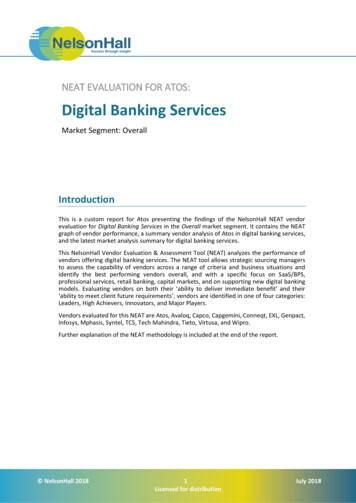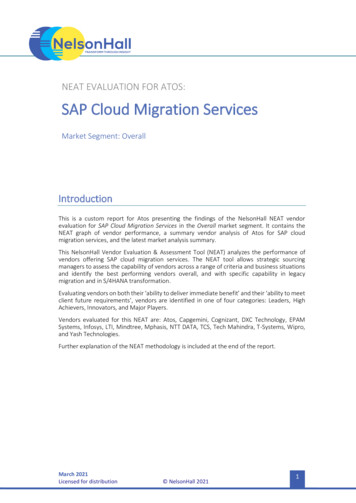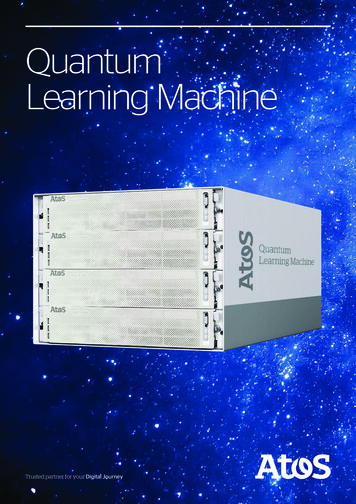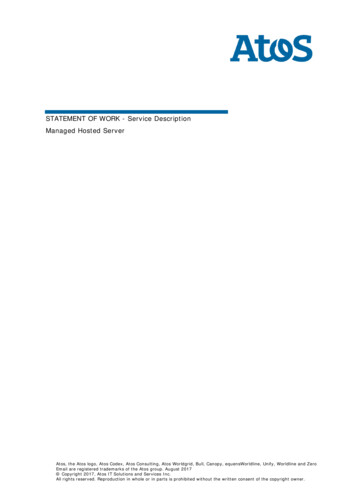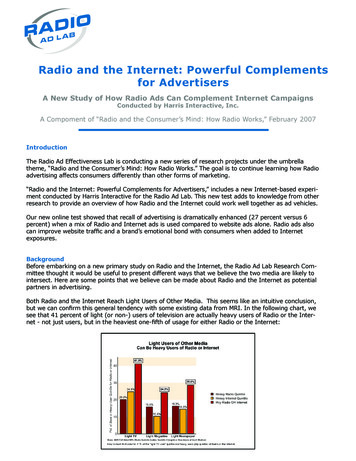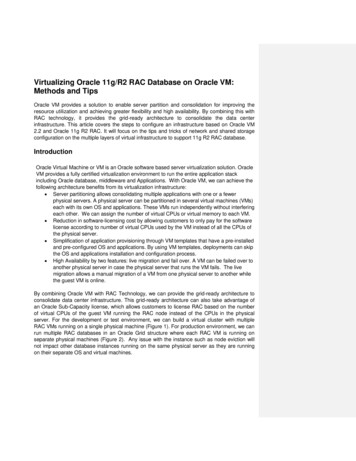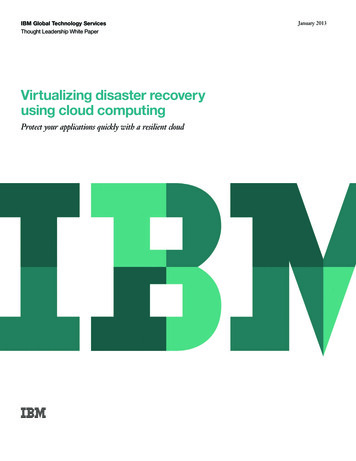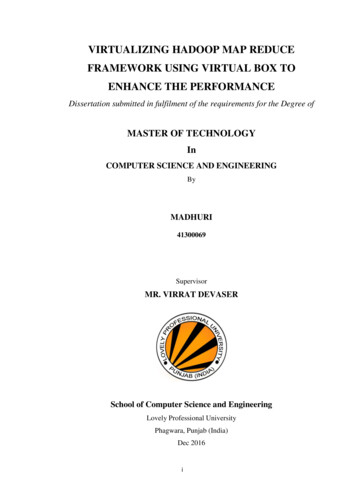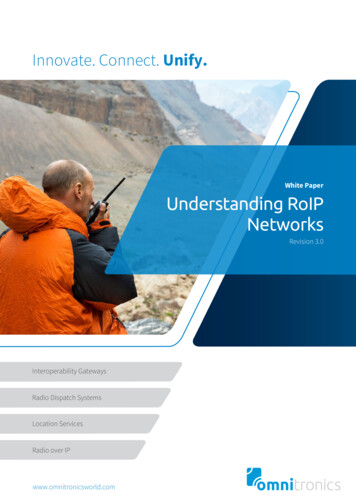
Transcription
Virtualizing RadioAccess Networks
Content03 Key opportunities and challengesfor telecom companies03 Business drivers for virtualizingRadio Access Networks04 Development of vRAN06 Role of the network integrator07 Importance of a partner ecosystem2
Key opportunities and challengesSummaryfor telecom companiesOnly a few years after the telecom NFV (Network Function Virtualization) revolution, a new trend in mobile digital communication has emerged:virtualization of the Radio Access Network (vRAN). Dedicated telecom appliances in the ‘micro-datacenters’ at the base of cellular radio towersare being replaced by industry-standard Intel servers, which run cloud-native network function software based on Kubernetes.Once again, IT meets telecom and two worlds converge. What’s more, this new telecom operator technology comes at precisely the right timefor 5G roll-out. So why should mobile carriers adopt it, and what is the safest way for them to do so?SummaryBusiness drivers for virtualizingRadio Access NetworksFor the highly distributed radio access networks of mobile carriers, vRAN is what classic NFV is for the core network. It improves agility; forexample, software updates and extensions are cheaper and easier to accomplish than appliance swaps. And it lowers total cost of ownershipand ease of maintenance; for example, novel future features may be available in software form only, meaning that expensive hardware doesn’tneed to be updated.In addition to these benefits come additional value propositions:TransparencyOpen-source software can be easily scannedfor security backdoors; appliances withproprietary firmware less so. Countriesconsidering telecom infrastructure a criticalasset of their national security will go fortransparent software and avoid deployingappliances from overseas vendors suspectedof a political agenda.vRAN can be utilized for 5G and LTE; solutions for 3G and before have also been announcedby the leading software vendors. By 2030, standardized Open RAN is expected to cover morethan half of all RAN deployments and establish a market estimated between tens to above 100billion USD. Accenture attributes 49% of CapEx savings to Open RAN. Goldman Sachs seesestimates the CapEx savings of Open RAN technology at 50%, and adds 35% OpEx savingson top.ColocationIn the near future, telecom operators arelikely to be expected to deliver value-addservices (VAS) out of their radio-tower‘micro-datacenters’, addressing ultrareliable low latency communication(URLLC) requirements as from connectedautonomous vehicles or life-supportingmedical equipment. The 3GPP globalinitiative ensures that emerging technologiesare compatible with usable radio accessnetworks, service and systems aspects, andcore networks and terminals. With each ofits releases outlining key milestones, 3GPPRelease 15 specifies a 1ms latency target,a figure that’s likely to be realistic only ifradio towers become part of the ‘far edge’for VAS delivery.Openness and inter-operabilityFigure 1: Datacenter LAN and LTE 5G RAN network stacks – a comparisonOpen RAN, specifically, promisesstandardized interfaces across allcomponents, so multi-vendor deploymentsare supported and vendor lock-inis prevented.VirtualizingRadioAccessNetworksTitleof thedocumenttext3
Development of vRANOnly a few years after the telecom NFV (Network FunctionVirtualization) revolution, a new trend in mobile digital communicationhas emerged: virtualization of the Radio Access Network (vRAN).Dedicated telecom appliances in the ‘micro-datacenters’ at the baseof cellular radio towers are being replaced by industry-standardIntel servers, which run cloud-native network function softwarebased on Kubernetes.Once again, IT meets telecom and two worlds converge. What’s more,this new telecom operator technology comes at precisely the righttime for 5G roll-out. So why should mobile carriers adopt it, and whatis the safest way for them to do so?The beginningsTraditionally, the BBU appliances have been housed in the ‘microdatacenter’ shed at the foot of, or integrated into, a radio tower. This iscalled a distributed RAN (dRAN – see Fig. 2).The idea emerged of centralizing the BBUs in a datacenter, andconnecting only the distributed radio units (RUs) through a so-calledfront-haul network line. This – the emergence of the centralized RAN(cRAN) – was in effect the birth of all virtualized RAN (vRAN), becausethe deployment of virtualized BBUs (vBBUs) on a datacenter NFVipod is an inviting bi-product of centralization. However, the RUs andantennae must stay where they are; and the front-haul connection isvery sensitive to bandwidth, latency and jitter effects, which limits theviability of the solution.In technical terms, the functional split between the RU and the vBBUwould be between the PHY (physical) and MAC (media access) layersin Fig. 1 – split option 6. Everything PHY and below is RU and antennamatter, everything MAC and above is vBBU responsibility.Where an optical or copper cable front-haul is possible over a shortdistance, cRAN solutions are clearly a viable choice. That can be thecase, for example, between an edge satellite datacenter and severalcell sites surrounding it.Figure 2: The evolution of RAN4
Disaggregation enters the sceneThe breakthrough of vRAN came with the disaggregation ofcomputationally intensive real-time functions – RLC (radio link control)and below in Fig. 1 – and non-real-time functions – PDCP (packet dataconvergence protocol) and above. Fig. 3 explains the architecture. RLCand below functions (except RF) are combined in the distributed unit(DU or, when virtualized, vDU), whereas PDCP and above go into thecentral unit (CU or vCU). The mid-haul network connection – that isthe name of the link connecting the DU and the CU – typically usessplit option 2 (Fig. 1). Of course it is possible to run the RU and thevDU in different locations, too, as in the dRAN approach. However, forthe split 7.2 between the two – discussed below under “connectingthe radio unit” – all the bandwidth, latency, and jitter challengesapply again.Disaggregated vRAN can be of the modern Open RAN variant,striving at standardization of all the relevant network interfaces – thefront-haul, the mid-haul, and the back-haul (between the vCU and thecell-site gateway router of the datacenter running the core network).O-RAN, specifically, stands for Open RAN from the O RAN Alliance, anassociation of vendors promoting Open RAN technology.A related development is control and user plane separation (CUPS),which keeps network control (e.g. connection setup) apart frompayload traffic processing. CUPS eases disaggregation and improvesscalability. (In Fig. 1, RRC proper is a control plane function. Theuser plane has its own protocols, such as SDAP – service dataadaptation protocol.)Needless to say, the DU – responsible for the real-time function in theRAN network stack – is a very sensitive component. It normally runson an edge server in the vicinity of the radio tower.Connecting the radio unitsIt is common today to use split option 7.2 (Fig. 1 and 3) for the fronthaul; in other words, the lower part of the PHY layer would be handledby the radio unit (RU) and the upper part by the vDU. Interfacespecifications like Common Public Radio Interface (CPRI) andenhanced CPRI (eCPRI) have emerged for this purpose.In 5G it has become standard practice to employ eCPRI and toalways virtualize the DU. Virtualization of the DU is based on networkfunction cloudification (NFC) with Kubernetes. NFC can be consideredthe successor of NFV.One of the best-known architectural blueprints for disaggregatedand virtualized RAN is the FlexRAN architecture by Intel. FlexRANstipulates an Intel field-programmable gate array (FPGA) acceleratorcard to offload computationally intensive signal processingworkload occurring in the DU. The typical hardware platformfor the vDU is a two-socket Intel server with one or two FPGAaccelerator cards, running (ideally) a real-time core Linux kernel andbare-metal Kubernetes.Figure 3: Disaggregated RANVirtualizing Radio Access Networks5
Role of the network integratorWhile the vision of Open RAN is intriguing, especially the vDU, its split 7.2eCPRI connection to the RU, and its hardware and bare-metal Kubernetesplatform harbor technical pitfalls. Carriers wishing to deploy vRAN todayhave the choice between buying an off-the-shelf solution – which maybe ‘half-Open RAN’ – and therefore risking vendor lock-in, or doing a lot oftheir own multi-vendor convergence testing.A smart third option is to employ a system ornetwork integrator who is knowledgeable inRAN technology. System integration costs areoffset by the price advantages of adopting anopen systems approach.Atos has many years of experience inbuilding IT cloud solutions, with bothconventional hypervisors and withKubernetes; since 2016, it the companyhas supported its telecom customers inNFVi implementation and virtual networkfunction (VNF) deployment. Atos is alsoknown for expertise in NFV managementand orchestration (MANO) solutions, andoperations support system (OSS) integration.A capable network integrator can beexpected to support telecom operators withthe following vRAN services: Assist with the development of a RANmodernization plan. Questions toaddress include the size and distributionof existing radio towers, extension plans(such as campus micro-cell offerings),the accessibility of the tower sites, or theavailability of edge datacenters nearby. Advise on technology and vendorselection. One important question whenchoosing an Open RAN product is how farback older mobile networks need to besupported: 5G and legacy LTE are implicit,but should 3G and/or 2G also be carried?In some geographies the lifecycles of 3Gand 2G are far from over, and compatibilityvRAN solutions are entering the market. Be prime contractor for the full roll-out androll-out testing programs. Design and build the infrastructure fromhardware – hyperscale architectures for thevCU and other central network functions,edge servers with FPGA cards for the vDU– through operating platforms, typically aKubernetes execution environment. Increasingly, decarbonization of theRadio Access Network plays a role. 5G isan energy-saving technology becauseadvances in massive multiple-input andmultiple-output (mMIMO) antennae andrelated technologies significantly reducethe broadcast energy needed to transmita certain amount of information over agiven distance – the ‘GByte per kJoule’parameter; overall energy, asset andavailability management of the (potentiallysolar-powered) cell sites is of increasingimportance. Atos runs a number of projectsto create a digital twin of a carrier’s networkand to employ data analytics and AI tooptimize asset management, maintenanceand energy cost. Execute lab tests and proofs of conceptfor the complete vRAN system. Atosoperates a telecom solutions lab inGrenoble, France, which conductsinteroperability tests and custom solutiondevelopment. On top of that, many telecomoperators wish to set up an on-premisereference proof of concept before startingthe roll-out of a RAN modernizationprogram. Together with partners, Atos canalso deliver Labs as a Service (LaaS). Implement xApps integration between theRAN intelligent controller (RIC) and multiaccess edge computing (MEC) platforms.This feature, which is new to 5G withO-RAN, offers powerful network control to5G-based edge application of the future.Complex roll-out programs should by iterative, following a PLAN-DO-CHECK-ACT Deming methodology (Fig. 4): Execution of a PLAN – theDOing – needs to be followed by a CHECK step, and by ACTing on the results of this check, i.e. immediate implementation of necessary andviable improvements. Lessons learned in each iteration feed into the fine-tuned PLANning of the subsequent phase of the program.Open RAN is a new technology in motion,subject to rapid ongoing development.Expertise is hard to find and needs to beupdated and maintained. Experience frompast enterprise IT cloud and from corenetwork NFV projects is a key foundation tocontinually evaluate the status of technology,and to keep vRAN projects smooth and opento ongoing technological progress.Figure 4: PLAN-DO-CHECK-ACT Deming Wheel.6
Importance of a partner ecosystemThe Open RAN product scene is rapidly evolving and innovations enterthe market fast. Another important role of an effective network integratoris therefore to connect with, and open up access to, specialist partners andniche providers.For any telecom company, waiting forprogress to slow is unlikely to be the rightstrategy. Cooperating and collaboratingwith the leaders in critical componenttechnologies and making sure there is aninnovation roadmap is the way to go. (Afterall, an open technology roadmap is one ofthe reasons why many telecom operatorsshun proprietary solutions and subscribe toopen-systems solutions.)A good system integrator will maintain closealliances with an ecosystem of technologyleaders in two independent areas in orderto ensure continuous up-to-date technologyreadiness (see Fig. 5):Figure 5: System integration partner ication-level partners, who offer vDU and vCU software (typicallyIntel FlexRAN) and ensure eCPRI and split-7.2 compatibility witheligible radio units.Infrastructure-level partners, who offer suitable HW (servers, FPGAaccelerators) and platforms (bare-metal Kubernetes, Kuberneteson OpenSTack, and more). That is complemented by the AtosBullSequana product line of datacenter and edge servers.This kind of dual-type, carefully maintained partner ecosystem, in combination with years of cloud and NFV integrator expertise, stronglycontributes to de-risking RAN modernization projects for any telecom operator that wants to be innovative and strictly vendor-independent.Virtualizing Radio Access Networks7
White PaperAbout AtosAtos is a global leader in digital transformationwith 105,000 employees and annual revenueof over 11 billion. European number one incybersecurity, cloud and high performancecomputing, the Group provides tailoredend-to-end solutions for all industries in 71countries. A pioneer in decarbonizationservices and products, Atos is committed to asecure and decarbonized digital for its clients.Atos operates under the brands Atos andAtos Syntel. Atos is a SE (Societas Europaea),listed on the CAC40 Paris stock index.The purpose of Atos is to help design thefuture of the information space. Its expertiseand services support the development ofknowledge, education and research in amulticultural approach and contribute to thedevelopment of scientific and technologicalexcellence. Across the world, the Groupenables its customers and employees, andmembers of societies at large to live, workand develop sustainably, in a safe and secureinformation space.Find out more about usatos.netatos.net/careerLet’s start a discussion togetherAtos, the Atos logo, Atos Syntel are registered trademarks of theAtos group. 2021 Atos. Confidential information owned by Atos,to be used by the recipient only. This document, or any part ofit, may not be reproduced, copied, circulated and/or distributednor quoted without prior written approval from works-en v7
Figure 1: Datacenter LAN and LTE 5G RAN network stacks - a comparison Title of the document text 3 Only a few years after the telecom NFV (Network Function Virtualization) revolution, a new trend in mobile digital communication has emerged: virtualization of the Radio Access Network (vRAN). Dedicated telecom appliances in the 'micro .
